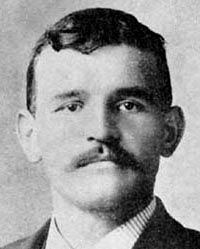
Gustave Albin Whitehead (1874 - 1927)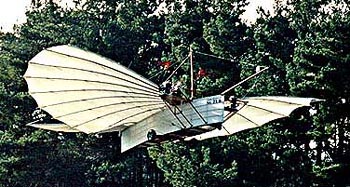 Recreation of Gustave Whitehead's flight on August 14, 1901
"On August 14, 1901, almost two and one half years before the Wright Brothers flew at Kitty Hawk, Gustave Whitehead ... lifted his acetylene-powered monoplane into the air at Fairfield, Connecticut, for his first flight." So reads one of the documents presented in the Gustave Whitehead museum in Leutershausen in Germany...Furthermore, one can read that the machine included advanced features such as a powered landing gear, folding wings and adjustable pitch propellers. ....Why then ...can he be virtually unknown? http://airsports.fai.org/jun98/jun9805.html
The story of Gustave A. Whitehead (Gustav Albin Weißkopf) is well documented on the web and in print. It would therefore be pointless to duplicate the detailed information on the following selected pages. For a quick summary of the machine though...
A New Flying Machine A novel flying machine has just been completed by Mr. Gustave Whitehead, of Bridgeport, Conn., and is now ready for the preliminary trials. Several experiments have been made, but as yet no free flights have been attempted. The machine is built after the model of a bird or bat. The body is 16 feet long and measures 2 1/2 feet at its greatest width and is 3 feet deep.
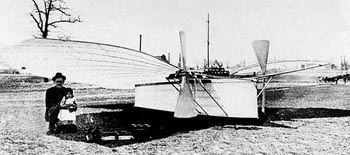 Whitehead Aeroplane No. 21 http://www.weisskopf.de/research.htm
It is well stayed with wooden ribs and braced with steel wires and covered with canvas which is tightly stretched over the frame, Four wheels, each one foot in diameter, support it while it stands on the ground. The front wheels are connected to a l0 horse power engine to get up speed on the ground, and the rear wheels are mounted like casters so that they can be steered by the aeronaut.
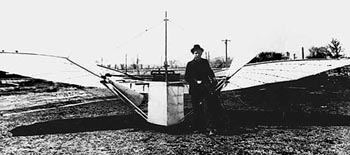 Whitehead Aeroplane No. 21 http://www.weisskopf.de/research.htm
On either side of the body are large aeroplanes, covered with silk and concave on the underside, which give the machine the appearance of a bird in flight. The ribs are bamboo poles, and are braced with steel wires. The wings are so arranged that they can be folded up. The 10-foot rudder, which corresponds to the tail of a bird, can also be folded up and can be moved up and down, so as to steer the machine on its horizontal course. A mast and bowsprit serve to hold all the parts in their proper relation.
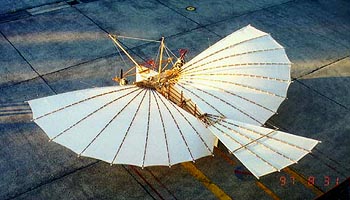 Whitehead Aeroplane No. 21, replica Download a 750pixel image http://www.weisskopf.de/research.htm
In front of the wings and across the body is a double compound engine of 20 horse power, which drives a pair of propellers in opposite directions, the idea being to run the machine on the ground by means of the lower engine until it has the necessary speed to rise from the ground. Then the upper engine actuates the propellers so as to cause the machine to progress through the air to make it rise on its aeroplanes.
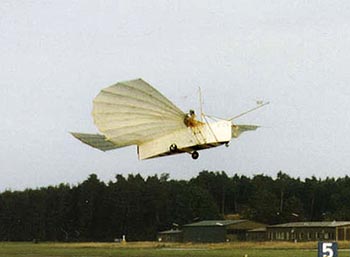 Whitehead No. 21, replica, in flight Download a 750pixel image http://www.weisskopf.de/research.htm
The wings are immovable and resemble the outstretched wings of a soaring bird. The steering will be done by running one propeller faster than the other in a way analogous to the way in which an ocean steamer having twin screws can be turned, a special aeroplane being provided to maintain longitudinal and transverse stability. The lower engine is of 10 horse power, and weighs 22 pounds. The diameter of the cylinder is 3 7-16 inches by 8 inches stroke. The upper engine is a double compound cylinder, the diameters being 2 1/4 and 3 7-16 inches with a 7-inch stroke. The engine weighs 35 pounds, and calcium carbide is used to develop pressure by means of explosions. The propellers weigh 12 pounds, and are 6 feet in diameter, with a projected blade surface of 4 square feet. With a drawbar test, the upper engine being run at full speed, the dead pull was 365 pounds. The weight of the body and wheels is 45 pounds. The wings and tail have 450 square feet of supporting surface, and the weight is 35 pounds.
In late 1963, the dilemma of attempting to determine how Gustave A. Whitehead fits into early powered flight history was more or less thrust upon our then very active 9315th USAF Reserve Squadron in Stratford, Connecticut. The question we were to answer was a tough one: did or did not Whitehead fly with power before the December 17, 1903, events at Kitty Hawk? ...more
Did He Actually Fly before the Wright Brothers Of the first flight of the aircraft N. 21, designed and constructed in 1901 in Connecticut by the Bavarian Gustav Weisskops (subsequently Whitehead), only testimonies of dead persons remain, but no photographic documentation in flight, gone destroyed. Perhaps this, with other complex and also incredible reasons, can only partially justify the total absence of this pioneer of aviation from the history of flight....more
http://www.first-to-fly.com Of all the people who claim to have flown before the Wright brothers, perhaps the most controversial is Gustave Whitehead. Whitehead, or Weisskopf in his native language, was a German immigrant with an undeniable passion for aviation. One biography tells that he was fascinated with Otto Lillienthal's gliding flights and was inspired to make a glider when he was 13 years old. The glider was unsuccessful, but it was still quite an accomplishment considering Whitehead would have been 13 in 1887, well before Lillienthal built his first glider. The general public would have to wait another three years to be inspired by Lillienthal's flights. ...more also the included article from Popular Aviation, January 1935
Did Whitehead Precede Wright In World's First Powered Flight?
Gustav Whitehead's Flying Machine Two years, four months and three days before the successful flights of the Wright brothers at Kitty Hawk, a birdlike monoplane took to the air at early dawn on August 14, 1901, near Bridgeport, Connecticut, carrying its inventor and builder, Gustave Whitehead, a distance of approximately a half mile. So reported the Bridgeport Herald, the New York Herald and the Boston Transcript....more
Experiments with motor driven aeroplanes Our illustrations (not available here - Ed.) depict experiments with an aeroplane carried out recently by Mr. Gustave Whitehead, of Bridgeport, Conn., who has been studying the subject of mechanical flight for upward of fifteen years. In one of the pictures is shown a light-weight, two cycle motor, which was used on the aeroplane in a recent experiment. ...more
AVWeb Profiles Academy award winner and TV star Cliff Robertson is as comfortable in the air as on the air. When he's not acting or directing in movies or TV, you'll find him flying or promoting aviation or winning an award for doing one or the other. In this month's Profile, Cliff talks with AVweb's Joe Godfrey about his prolific career on both sides of the camera, his collection of airplanes, and his lifelong passion for flying. ...more
Gustav Weißkopf (Gustave Whitehead) As a young mariner, Gustav Weißkopf made many sea voyages for several years, became familiar with wind and weather, and was an avid observer of sea birds, which made a permanent impression upon him. Intrigued with the idea of manned flight, he returned to Germany in order to meet Otto Lilienthal. With this inspiration, and study of relevant material at libraries, his new course was set....more
Further Reading
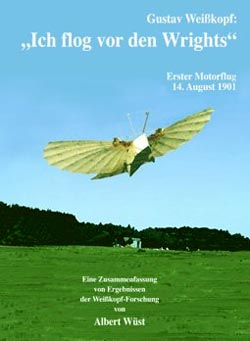 Wüst, Albert, Gustav Weißkopf : Ich Flog vor den Wrights, ISBN 3-922 175-39-2 http://www.weisskopf.de/bestell.htm
Dem aus Deutschland in die USA ausgewanderten Franken Gustav Weißkopf gelang in den frühen Morgenstunden des 14. August 1901 sein erster Motorflug. Zwei Jahre, vier Monate und drei Tage vor dem ersten Flug der Gebrüder Wright legte er unweit von Bridgeport im US-Staat Connecticut mit seiner Flugmaschine, angetrieben durch von ihm selbst gebaute Motoren, 800 Meter in der Luft zurück. Über Gustav Weißkopf, seinen ersten Motorflug, seine Erfindungen, seine Pioniertaten und sein Leben berichtet dieses Buch; auch darüber, wie er aus der Vergessenheit gehoben und ihm Anerkennung zuteil wurde.
|
© Copyright 1999-2002 CTIE - All Rights Reserved - Caution |
